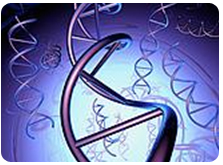
Genetic tests are now available to detect the presence of a number of high and lower penetrance inherited cancer susceptibility genes:
Familial Adenomatous Polyposis (FAP) – highly penetrant
FAP is a condition which causes hundreds of polyps to develop in the colon, and they begin to appear at an average age of 16 years. The risk of colorectal cancer developing from a polyp is virtually 100 per cent unless prophylactic (before symptoms) removal of the colon is carried out. Polyps also develop in the upper gastrointestinal tract and cancer may occur in other sites including the brain and the thyroid (although not as frequently). The penetrance of FAP is 95-100 per cent meaning that most people who carry a faulty gene for this condition will develop the cancer unless they have prophylactic surgery.
Multiple Endocrine Neoplasia 2 (MEN 2) – highly penetrant
MEN2 is a complex inherited condition that causes a predisposition to various cancers, often with different risks. For example, medullary thyroid cancer, parathyroid adenomas and an adrenal tumour called a phaeochromocytoma. Because of the difficulty of screening for the thyroid cancer it is recommended that children diagnosed with MEN2 have the thyroid gland removed in early childhood to prevent them from developing this cancer. If they do not, the risk of medullary thyroid cancer is very high. If the thyroid gland is removed, it is still necessary to screen for adrenal tumours, which may develop in adulthood. The penetrance for the thyroid cancer is 95 per cent in most families (although the other cancers develop less frequently), with an age at diagnosis between 20-40 years for thyroid cancer, and later for the adrenal tumours. Affected people often develop parathyroid tumours but these are not usually malignant. The risk of specific tumours varies with different faults in the same gene.
Retinoblastoma – highly penetrant
Retinoblastoma is a cancer which develops in the cells of the retina, the light sensitive lining of the eye. In cases of inherited retinoblastoma, the penetrance is about 90 per cent. The tumour usually develops before the age of 5 years and some children are born with retinoblastoma. Children with bilateral (both eyes) disease tend to present during the first year of life whilst the peak age of diagnosis for children with unilateral disease (one eye) is between 24 and 30 months.
Breast cancer and ovarian cancer – lower penetrance
Inherited forms of breast and ovarian cancer can both be caused by faults in the BRCA1 and BRCA2 genes (BReast CAncer). Around 5-10 per cent of all breast and ovarian cancer are caused by an inherited fault in one of these predisposition genes. The age at diagnosis for breast cancer in women with such an inherited fault is about 10 to 20 years earlier than for sporadic breast cancer. Women who carry a fault in the BRCA1 gene have a lifetime risk of breast cancer of about 80 per cent, and 40 per cent of ovarian cancer — women carrying a fault in the BRCA2 gene have a similar risk of breast cancer but a smaller risk of ovarian cancer. Men carrying these mutations have some increase of prostate cancer risk, and men who carry an alteration in the BRCA2 gene have a 5-7 per cent risk of developing breast cancer in their lifetime. Screening measures are not sufficiently sensitive and specific at present and so prophylactic options to reduce the risks of breast and ovarian cancer (mastectomy and oophorectomy) are often considered, although management of these risks is likely to improve with time.
Bowel cancer (Hereditary non-polyposis colorectal cancer (HNPCC)) – lower penetrance
Individuals with HNPCC have up to an 80 per cent lifetime risk of colorectal cancer and increased risks of uterine cancer (up to 60 per cent) and other mostly gastrointestinal cancers. Screening is available by colonoscopies annually from 25 years, and ultrasound scans may be offered to women with HNPCC. The age at diagnosis of colorectal cancer in the condition is usually in the forties but can be earlier.
The two most prevalent syndromes are breast and hereditary non-polyposis colon cancers that are associated with mutations in the BRCA1/2 genes and MSH2 /MLH1 genes respectively. Other syndromes include multiple endocrine neoplasia (MEN1, MEN2 genes), retinoblastoma (RB1 gene), Neurofibromatoses (NF1, NF2 genes), Li Fraumeni syndrome (p53 gene) and Familial Polyposis (FAP gene).
All these cancers are autosomal dominant traits that usually manifest in adulthood, but can occur occasionally in children. Malfunction of tumour suppressor genes, impairment of DNA repair genes or the transformation of a normal gene into an oncogene are well known events that lead to the development of these genetic cancers. The lifetime risk for an individual carrying a cancer-predisposing gene mutation to develop disease is <100%. People who inherit specific p53 suppressor gene mutations have a high chance of developing Li-Fraumeni syndrome that frequently manifests as breast tumours or bone and soft tissue sarcomas.
Their chance of developing a tumour by age 30 years is 50% (compared with 1% in the general population) and by age 70, the chance escalates to 90%. The lifetime risk for women who inherit either a BRCA1 or BRCA2 cancer gene is equally high. For example, by the age of 70, the lifetime risk of breast cancer is in the order of 60–80%, with an additional lifetime risk of 20–40% for ovarian cancer. For women in the general population without the mutation, there is only an 8% lifetime risk of developing breast cancer.